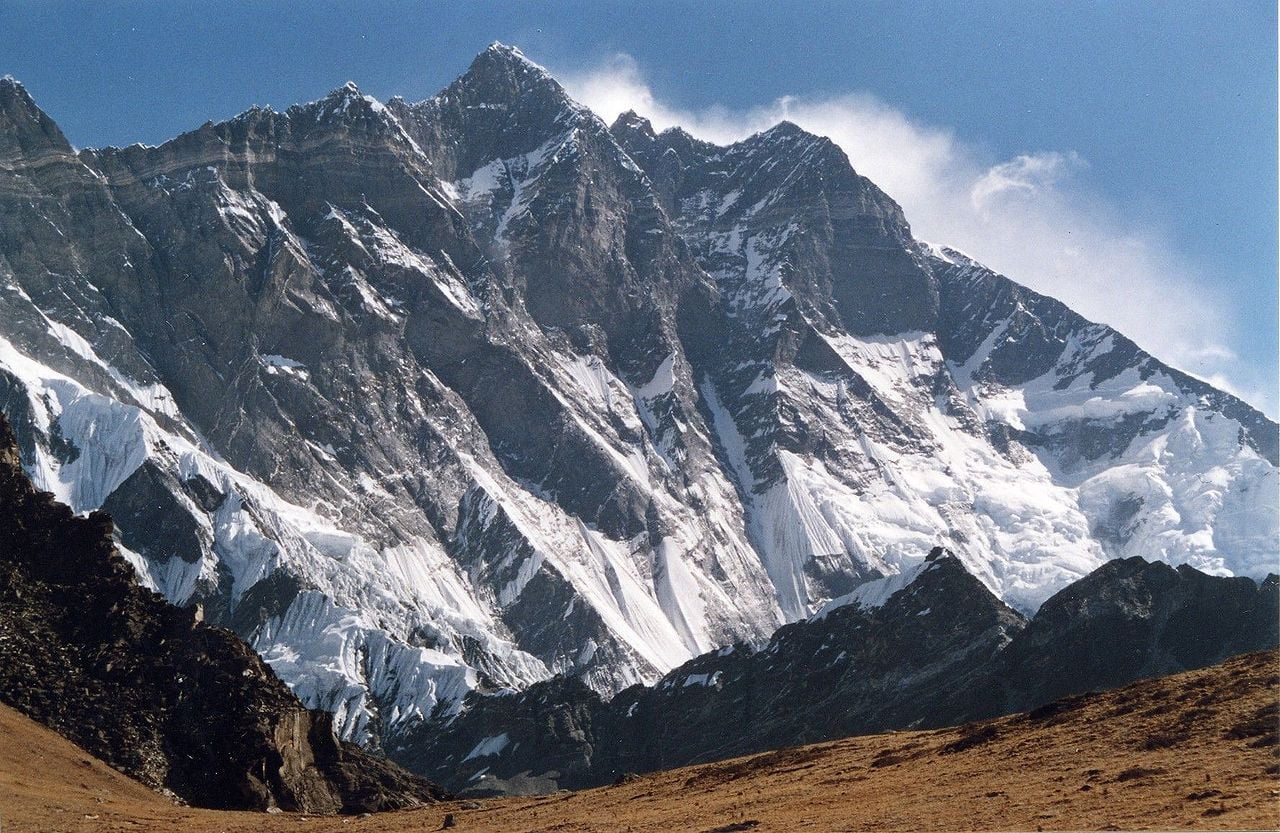At 8,516 meters (27, 890 feet) above sea level, Mount Lhotse is the fourth-highest summit in the world. Lhotse is a Himalayan Mountain that can be found in 27°57′42″ north latitude and 86°56′00″ east longitude. Lhotse, which is 3 kilometers south of Mount Everest, is referred to as the “south peak” in Tibetan. Everest and Lhotse are connected by the “South Col.” Lhotse has three peaks, the lowest of which is 8,383 meters high (Lhotse Shar). Lhotse East, also known as Mid, is the second-highest mountain in terms of altitude at 8,413 meters. The tallest peak, Lhotse Main, is 8,516 meters high. It was finally reached for the first time in 1956. It’s noteworthy to note that the first full ascent of Lhotse Middle took place only in 2001.
Tibetan speakers sometimes refer to Lhotse Peak as “Dingjie Xie Sangma,” which means “blue and lovely fairy.” It is surrounded by the peak’s northeast and north ridges. Its western half is a part of the Kingdom of Nepal, and its eastern side is located in the Tibet Autonomous Region of China.
Location of Mt. Lhotse
Part of the Everest Massif is Mount Lhotse. Tibetans refer to the peak as “South Peak.” The peak, which is also known by the moniker E1, is located on the boundary between China’s Tibet Autonomous Region and Nepal. The peak is located in Nepal’s Sagarmatha National Park and is connected to Mount Everest by the South Col. Before hikers reach the top of Mount Everest or Mount Lhotse, they must first pass through the South Col base camp.
Characteristics of Mt. Lhotse
The gorgeous, steep mountains frequently experience avalanches, ice avalanches, and glaciers. Massive glaciers and thousands of years’ worth of moraine blanket the area, especially from the base camp to the No. 1 camp. The journey is lengthy, the terrain is difficult, the ice slope is steep, and there are several enormous ice fissures. The ice slope is 75 degrees, with some parts reaching 85 degrees or more, and the average snow depth is 60 to 65 cm.
Lhotse features many satellite summits in addition to its main peak, which rises to a height of 8,516 meters (27,940 feet). Nepal is home to Lhotse South, which rises 8,426 meters (27,644 feet) above sea level. Lhotse Middle I, also known as Lhotse Middle, is a mountain in Tibet and Nepal that rises 8,413 meters (27,592 feet) above sea level. On May 23, 2001, a Russian climbing team became the first to reach the summit. Lhotse Middle II is a Himalayan Mountain that can be found in Nepal and is 8,383 meters (27,467 feet) above sea level. On the border between Tibet and Nepal lies Lhotse Shar. An Austrian climbing team reached the summit on May 12, 1970.
Climbing History of Mt. Lhotse
In 1955, the International Himalayan Expedition undertook the first-ever effort to scale the mountain. There were 200 native porters and several Sherpas with the crew. However, they altered their minds about the Western Cwm valley and the north face of the Lhotse after seeing the massive southern face of the Lhotse Shar. They were able to reach a height of 8,100 meters.
A Swiss team successfully ascended the main peak a year later, in 1956. Lhotse Shar was first climbed on May 12, 1970, continuing the climb. The highest unclimbed point on Earth, Lhotse Middle, remained unclimbed for a very long period. Finally, a Russian expedition made history by successfully making the first ascent on May 23, 2001.
Difficulty Level to Reach Mt. Lhotse
The rewarding time for travelers to approach the Lhotse Mountain is in the spring. Due to the mountain’s stunning and dangerous top, the adventure there calls for a high degree of experience. The travelers may be seriously threatened by the snow and ridges.
One of the world’s toughest trips is the ascent of Lhotse. The likelihood of an avalanche and the shortage of oxygen are both quite high. A qualified guide is more than required for the adventure. The ascent of the mountain is a true challenge that has already claimed several lives. Thus, summit-making requires more than simply confidence. For your adventure, make sure you are well prepared and in a nice group.
Getting to Mt. Lhotse
Undoubtedly one of the most challenging and deadly mountain climbs is Lhotse. There are only three hiking paths that may take you to the mountain’s summit: Lhotse main, which climbs the mountain’s west face, Lhotse middle, which passes via Lhotse main, and Lhotse Shar, which ascends the mountain’s south face. The most dangerous path is through the South Face. A lot of seasoned mountaineers throughout the world have failed on this path because it is so treacherous. The Tibetan Trails and Mount Lhotse are also visible from close up at Everest Base Camp.
-by: Kusum Kharel for Land Nepal




